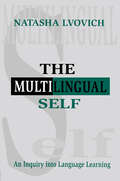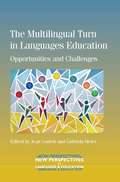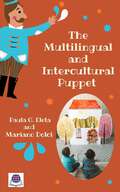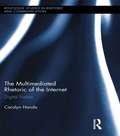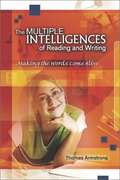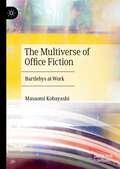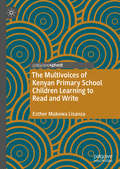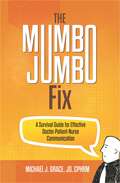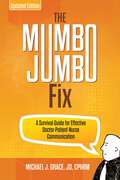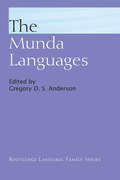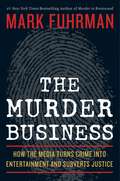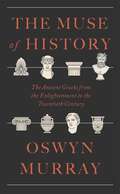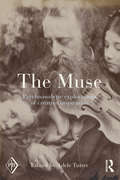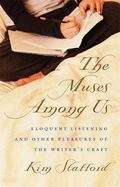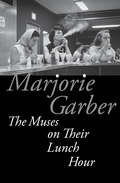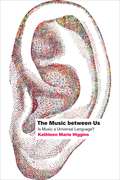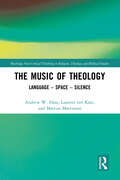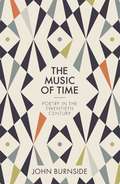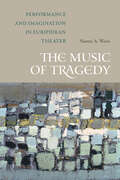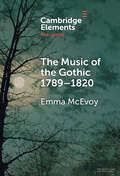- Table View
- List View
The Multilingual Self: An Inquiry Into Language Learning
by Natasha LvovichThis book relates the author's stories about how languages have integrated her being, and defined and formed her sense of self. The idea of writing autobiographical stories of her multilingual life came from her long-term commitment to foreign language teaching and from a recent, extremely rich and valuable experience teaching English to immigrants in the U.S. While reading and studying various aspects of second-language-related-theory -- linguistics, psychology, anthropology, and sociolinguistics literature -- the author realized how estranged language learners are from all the research, speculations, hypotheses, and achievements of scholarship. A Russian immigrant, the author tells stories to her ESL students to help them understand why and at what price successful language acquisition and acculturation is realistic. Not only can students learn from her stories which encourage discoveries about their own behaviors or problems, but they might want to respond and tell about their own struggles with a foreign language. By becoming writers and interpreters of her text and by making it their own, students can construct their own virtual texts. The stories told throughout are those of a language learner, who is also a linguist and language teacher. As such, they can bridge the gap between second language research and practical teaching and learning. Moreover, this book can help initiate language learners along with their teachers into scholarship. Second language teachers and graduate students preparing for a teaching career might see this book as an illustration and validation of the studied theory and an inner voice of their students at the same time. Multidisciplinary by nature, it can also be used in several college courses such as cultural anthropology, anthropo- and socio-linguistics, sociology, multicultural education, ethnography, bilingualism, and the study of immigrant experience. There are numerous applications of the book in the educational field at various levels of adult learning programs which might be determined by the objectives and by the instructor's vision of it in the curriculum. It is also intended as a message to the general public and to all thinking individuals in search of identity. It will popularize the idea of the importance of foreign language learning, language education, linguistic literacy, and metalinguistic awareness, of illuminating self-discovery through the treasure of multilingual experience, capable of giving birth to a new, sophisticated, spiritually complex and enriched multicultural identity.
The Multilingual Turn in Languages Education
by Jean Conteh Gabriela MeierStarting from the key idea that learners and teachers bring diverse linguistic knowledge and resources to education, this book establishes and explores the concept of the 'multilingual turn' in languages education and the potential benefits for individuals and societies. It takes account of recent research, policy and practice in the fields of bilingual and multilingual education as well as foreign and second language education. The chapters integrate theory and practice, bringing together researchers and practitioners from five continents to illustrate the effects of the multilingual turn in society and evaluate the opportunities and challenges of implementing multilingual curricula and activities in a variety of classrooms. Based on the examples featured, the editors invite students, teachers, teacher educators and researchers to reflect on their own work and to evaluate the relevance and applicability of the multilingual turn in their own contexts.
The Multilingual Turn: Implications for SLA, TESOL, and Bilingual Education
by Stephen MayDrawing on the latest developments in bilingual and multilingual research, The Multilingual Turn offers a critique of, and alternative to, still-dominant monolingual theories, pedagogies and practices in SLA, TESOL, and bilingual education. Critics of the ‘monolingual bias’ argue that notions such as the idealized native speaker, and related concepts of interlanguage, language competence, and fossilization, have framed these fields inextricably in relation to monolingual speaker norms. In contrast, these critics advocate an approach that emphasizes the multiple competencies of bi/multilingual learners as the basis for successful language teaching and learning. This volume takes a big step forward in re-situating the issue of multilingualism more centrally in applied linguistics and, in so doing, making more permeable its key sub-disciplinary boundaries – particularly, those between SLA, TESOL, and bilingual education. It addresses this issue head on, bringing together key international scholars in SLA, TESOL, and bilingual education to explore from cutting-edge interdisciplinary perspectives what a more critical multilingual perspective might mean for theory, pedagogy, and practice in each of these fields.
The Multilingual and Intercultural Puppet: An Innovative Approach to Learning Foreign and Second Langauges
by Paula G. Eleta Mariano DolciAs the world becomes increasingly more interconnected and globalized, increasingly more families are seeking early (0-6 years) foreign and second language education, prompting educators and teachers to seek out age-appropriate tools which offer an innovative approach to early language learning (ELL). The Multilingual and Intercultural Puppet tries to answer two questions: How can we introduce children to foreign languages at an early age in a natural and also naturally playful way? And with which approach? This book presents a documented reflection that is rooted in concrete experiences which the authors have accumulated over the past twenty years of field-work, providing readers with many innovative yet practical and operational examples of how puppets have been used to facilitate ELL. Puppets, easily integrated into chilren’s natural play environment, represent a pedagogical tool par excellence for the teaching-learning of foreign languages. Using puppets, educators can create stimulating and enriching learning contexts, engaging children and moving them towards educational learning objectives, very naturally and through active and interactive play. Moreover, puppets, being puppets, can speak various languages, experience various life-events, and share these with young learners, be they homogeneous, heterogeneous, international, transcultural and/or intercultural groups. Indeed, “the language of puppets” is naturally multilingual and intercultural.
The Multimediated Rhetoric of the Internet: Digital Fusion (Routledge Studies in Rhetoric and Communication #10)
by Carolyn HandaThis project is a critical, rhetorical study of the digital text we call the Internet, in particular the style and figurative surface of its many pages as well as the conceptual, design patterns structuring the content of those same pages. Handa argues that as our lives become increasingly digital, we must consider rhetoric applicable to more than just printed text or to images. Digital analysis demands our acknowledgement of digital fusion, a true merging of analytic skills in many media and dimensions. CDs, DVDs, and an Internet increasingly capable of streaming audio and video prove that literacy today means more than it used to, namely the ability to understand information, however presented. Handa considers pedagogy, professional writing, hypertext theory, rhetorical studies, and composition studies, moving analysis beyond merely "using" the web towards "thinking" rhetorically about its construction and its impact on culture. This book shows how analyzing the web rhetorically helps us to understand the inescapable fact that culture is reflected through all media fused within the parameters of digital technology.
The Multiple Intelligences of Reading and Writing: Making the Words Come Alive
by Thomas ArmstrongShows how using Multiple Intelligences will help students acquire reading and writing skills.
The Multiverse of Office Fiction: Bartlebys at Work
by Masaomi KobayashiThe Multiverse of Office Fiction liberates Herman Melville’s 1853 classic, “Bartleby, the Scrivener,” from a microcosm of Melville studies, namely the so-called Bartleby Industry. This book aims to illuminate office fiction—fiction featuring office workers such as clerks, civil servants, and company employees—as an underexplored genre of fiction, by addressing relevant issues such as evolution of office work, integration of work and life, exploitation of women office workers, and representation of the Post Office. In achieving this goal, Bartleby plays an essential role not as one of the most eccentric characters in literary fiction, but rather as one of the most generic characters in office fiction. Overall, this book demonstrates that Bartleby is a generative figure, by incorporating a wide diversity of his cousins as Bartlebys. It offers fresh contexts in which to place these characters so that it can ultimately contribute to an ever-evolving poetics of the office.
The Multivoices of Kenyan Primary School Children Learning to Read and Write
by Esther Mukewa LisanzaThis book provides a rich and nuanced examination of children learning to read and write a second language in primary schools in Kenya, taught by teachers who themselves have often learned English as a second or third language. The author uses two case studies, of an urban and a rural school, to explore how different socioeconomic and cultural contexts can affect the enactment of language policies and their effect on literacy. This book contributes a unique perspective to studies in language and literacy education due to its distinctive exploration of young children learning to read and write in the English language in Kenya, and it will be of particular interest to students and scholars of applied linguistics, language education, bilingualism and language policy.
The Mumbo Jumbo Fix: A Survival Guide for Effective Doctor-Patient-Nurse Communication
by Michael J. GraceThe Mumbo Jumbo Fix: A Survival Guide for Effective Doctor-Patient-Nurse Communication tackles the vital subject of healthcare miscommunication which is a leading cause of patient harm. It is the first book of its kind geared to all three essential
The Mumbo Jumbo Fix: A Survival Guide for Effective Doctor-Patient-Nurse Communication (UPDATED EDITION)
by Michael J. GraceThe Mumbo Jumbo Fix: A Survival Guide for Effective Doctor-Patient-Nurse Communication tackles the vital subject of healthcare miscommunication which is a leading cause of patient harm. It is the first book of its kind geared to all three essential
The Munda Languages (Routledge Language Family Series)
by Gregory D.S. AndersonThe Munda group of languages of the Austroasiatic family are spoken within central and eastern India by almost ten million people. To date, they are the least well-known and least documented languages of the Indian subcontinent. This unprecedented and original work draws together a distinguished group of international experts in the field of Munda language research and presents current assessments of a wide range of typological and comparative-historical issues, providing agendas for future research. Representing the current state of Munda Linguistics, this volume provides detailed descriptions of almost all of the languages in the family, in addition to a brief chapter discussing the enigmatic Nihali language.
The Murder Business: How the Media Turns Crime Into Entertainment and Subverts Justice
by Mark FuhrmanCrime stories fascinate the public. But between factual news stories, overblown "human interest" reports and salacious murder mystery exposés, it's difficult to tell where news ends and entertainment begins. Mark Fuhrman, best-selling author of Murder in Brentwood, explores this fine line and how it is increasingly being crossed, revealing new and shocking details on such highprofile cases as JonBenet Ramsey, Martha Moxley and Chandra Levy. In The Murder Business, Fuhrman argues that the media's approach to covering crime ("if it bleeds, it leads") has allowed many criminals to get away with murder and impeded the search for justice. The Murder Business presents a compelling plea for journalists, cops and citizens to demand higher ethical standards in the pursuit of justice.
The Murder Gang: Fleet Street’s Elite Group of Crime Reporters in the Golden Age of Tabloid Crime
by Neil RootThey were an elite group of renegade Fleet Street crime reporters covering the most notorious British crime between the mid-1930s and the mid-1960s. It was an era in which murder dominated the front and inside pages of the newspapers – the ‘golden age’ of tabloid crime. Members of the Murder Gang knew one another well. They drank together in the same Fleet Street pubs, but they were also ruthlessly competitive in pursuit of the latest scoop. It was said that when the Daily Express covered a big murder story they would send four cars: one containing their reporters, the other three to block the road at crime scenes to stop other rivals getting through. As a matter of course, Murder Gang members listened in to police radios, held clandestine meetings with killers on the run, made huge payments to murderers and their families – and jammed potatoes into their rivals’ exhaust pipes so their cars wouldn’t start. These were just the tools of the trade; it was a far cry from modern reporting. Here, Neil Root delves into their world, examining some of the biggest crime stories of the era and the men who wrote them. In turns fascinating, shocking and comical, this tale of true crime, media and social history will have you turning the pages as if they were those newspapers of old.
The Muse of History: The Ancient Greeks from the Enlightenment to the Present
by Oswyn MurrayHow the modern world understood the ancient Greeks and why they matter today.“This majestic book by Oswyn Murray has been long and eagerly awaited…and its quality and scope exceed expectations.” —Edith Hall, BBC History MagazineThe study of ancient Greece has been central to Western conceptions of history since the Renaissance. The Muse of History traces the shifting patterns of this preoccupation in the last three centuries, in which successive generations have reinterpreted the Greeks in the light of their contemporary worlds. Thus, in the eighteenth century, the conflict between Athens and Sparta became a touchstone in the development of republicanism, and in the nineteenth, Athens came to represent the democratic ideal. Amid the ideological conflicts of the twentieth century, the Greeks were imagined in an age of suffering, inspiring defenses against nationalism, Nazism, communism, and capitalism.Oswyn Murray draws powerful conclusions from this historiography, using the ever-changing narrative of ancient Greece to illuminate grand theories of human society. Analyzing the influence of historians and philosophers including Hegel, Burckhardt, Nietzsche, and Braudel, Murray also considers how coming generations might perceive the Greeks. Along the way, The Muse of History offers rare behind-the-scenes glimpses of figures who shaped the study of ancient Greece, some devotedly cited to this day and others forgotten. We sit in on a class with Arnaldo Momigliano; meet Moses Finley after his arrival in England; eavesdrop on Paul Veyne, Jean-Pierre Vernant, and Pierre Vidal-Naquet; and rediscover Michel Foucault.A thrilling work that rewrites established scholarly traditions and locates important ideas in unexpected places, The Muse of History reminds us that the meaning of the past is always made in and for the present.
The Muse: Psychoanalytic Explorations of Creative Inspiration (Psychoanalytic Inquiry Book Series)
by Adele TutterPsychoanalysts have long been fascinated with creative artists, but have paid far less attention to the men and women who motivate, stimulate, and captivate them. The Muse counters this trend with nine original contributions from distinguished psychoanalysts, art historians, and literary scholars—one for each of the nine muses of classical mythology—that explore the muses of disparate artists, from Nicholas Poussin to Alison Bechdel. The Muse breaks new ground, pushing the traditional conceptualization of muses by considering the roles of spouse, friend, rival, patron, therapist—even a late psychoanalytic theorist—in facilitating creativity. Moreover, they do so not only by providing inspiration, but also by offering the artist needed material and emotional support; tolerating competitive aggression; promoting reflection and insight; and eliciting awe, anxiety and gratitude. Integrating art history and literary criticism with a wide spectrum of contemporary psychoanalytic perspectives, The Muse is essential reading for psychoanalysts and psychotherapists interested in the relationships that enhance and support creative work. Fully interdisciplinary, it is also accessible to readers in the fields of art, art history, literature, memoir, and film. The Muse sheds new light on that most mysterious dyad, the artist and muse—and thus on the creative process itself.
The Muses Among Us: Eloquent Listening And Other Pleasures Of The Writer's Craft
by Kim StaffordThe Muses Among Us is an inviting, encouraging book for writers at any stage of their development. In a series of first-person letters, essays, manifestos, and notes to the reader, Kim Stafford shows what might happen at the creative boundary he calls "what we almost know." On the boundary's far side is our story, our poem, our song. On this side are the resonant hunches, griefs, secrets, and confusions from which our writing will emerge. Guiding us from such glimmerings through to a finished piece are a wealth of experiments, assignments, and tricks of the trade that Stafford has perfected over thirty years of classes, workshops, and other gatherings of writers. <P><P> Informing The Muses Among Us are Stafford's own convictions about writing--principles to which he returns again and again. We must, Stafford says, honor the fragments, utterances, and half-discovered truths voiced around us, for their speakers are the prophets to whom writers are scribes. Such filaments of wisdom, either by themselves or alloyed with others, give rise to our poems, stories, and essays. In addition, as Stafford writes, "all pleasure in writing begins with a sense of abundance--rich knowledge and boundless curiosity." By recommending ways for students to seek beyond the self for material, Stafford demystifies the process of writing and claims for it a Whitmanesque quality of participation and community.
The Muses on Their Lunch Hour
by Marjorie Garber&“Witty, shrewd, and imaginative essays on interdisciplinary topics . . . from Shakespeare to psychoanalysis, and the practice of higher education today.&” —Publishers Weekly As a break from their ordained labors, what might the Muses do on their lunch hour today? This collection of essays uses these figures of ancient legend to explore such modern-day topics as the curious return of myth and ritual in the theories of evolutionary psychologists and much more. Two themes emerge consistently. The first is that to predict the &“next big thing&” in literary studies, we should look back at ideas and practices set aside by a previous generation of critics. In the past several decades we have seen the reemergence of—for example—textual editing, biography, character criticism, aesthetics, and philology as &“hot&” new areas for critical intervention. The second theme expands on this observation, making the case for &“cultural forgetting&” as the way the arts and humanities renew themselves, both within fields and across them. Although she is never represented in traditional paintings or poetry, a missing Muse—we can call her Amnesia—turns out to be a key figure for the creation of theory and criticism in the arts.
The Music between Us: Is Music a Universal Language?
by Higgins Kathleen MarieFrom our first social bonding as infants to the funeral rites that mark our passing, music plays an important role in our lives, bringing us closer to one another. In The Music between Us, philosopher Kathleen Marie Higgins investigates this role, examining the features of human perception that enable music's uncanny ability to provoke, despite its myriad forms across continents and throughout centuries, the sense of a shared human experience. Drawing on disciplines such as philosophy, psychology, musicology, linguistics, and anthropology, Higgins's richly researched study showcases the ways music is used in rituals, education, work, healing, and as a source of security and--perhaps most importantly--joy. By participating so integrally in such meaningful facets of society, Higgins argues, music situates itself as one of the most fundamental bridges between people, a truly cross-cultural form of communication that can create solidarity across political divides. Moving beyond the well-worn takes on music's universality, The Music between Us provides a new understanding of what it means to be musical and, in turn, human.
The Music in African American Fiction: Representing Music In African American Fiction (Routledge Library Editions: African American Literature #2)
by Robert H. CataliottiOriginally published in 1995, The Music of African American Fiction is a historical analysis of the tradition of representing music in African American fiction. The book examines the impact of evolving musical styles and innovative musicians on black culture as is manifested in the literature. The analysis begins with the slave narratives and the emergence of the first black fiction of the antebellum years and moves through the Reconstruction. This is followed by analyses of definitive fictional representations of African American music from the turn-of-the-century through Harlem Renaissance, the Depression and World War II eras through the 1960s and the Black Arts Movement. The representation of black music shapes a lineage that extends from the initial chronicles written in response to sub-human bondage to the declarations of an autonomous "black aesthetic" and dramatically influences the evolution of an African American literary tradition.
The Music of Humanity: A Critical Study of Wordsworth's Ruined Cottage Incorporating Texts from a Manuscript of 1799—1800
by Jonathan WordsworthA careful analysis including biographical information.
The Music of Theology: Language – Space – Silence (Routledge New Critical Thinking in Religion, Theology and Biblical Studies)
by Andrew Hass Mattias Martinson Laurens ten KateThis book reconceives theology as a musical endeavour in critical tension with language, space and silence. An Overture first moves us from music to religion, and then from theology back to music – a circularity that, drawing upon history, sociology, phenomenology, and philosophy, disclaims any theology of music and instead pursues the music in theology. The chapters that follow explore the three central themes by way of theory, music and myth: Adorno, Benjamin and Deleuze (language), Derrida, Rosa and Nancy (space), Schelling/Hegel, Homer and Cage (silence). In overdubbing each other, these chapters work towards theology as a sonorous rhythm between loss and freedom. A Coda provides three brief musical examples – Thomas Tallis, György Ligeti, and Evan Parker – as manifestations of this rhythm, to show in summary how music becomes the very pulse of theology, and theology the very intuition of music. The authors offer an interdisciplinary engagement addressing fundamental questions of the self and the other, of humanity and the divine, in a deconstruction of modern culture and of its bias towards the eye over the ear. The book harmonizes three scholarly voices who attempt to find where the resonance of our Western conceptions and practice, musically and theologically, might resound anew as a more expansive music of theology.
The Music of Time: Poetry in the Twentieth Century
by John BurnsideA revelatory and deeply personal history of twentieth-century poetry by prize-winning poet and memoirist John BurnsidePoetry helps us to make sense of our world, transforming what the Russian poet Osip Mandelstam called the "noise of time" into a kind of music. The Music of Time is a unique history of twentieth-century poetry by one of today's most acclaimed poets, blending incandescent personal meditations with rare insights about a broad range of poets who distilled the essence of the moment, gave voice to our griefs and joys, and shaped our collective memory.Bringing together poets from times and places as diverse as Tsarist Russia, 1960s Harlem, and Ireland at the height of the Troubles, Burnside reveals how poetry responded to the dramatic events of the century while shaping our impressions of them. He takes readers from the trenches of World War I to a prison cell in Nazi Germany, and from Rilke's grave in the Swiss Alps to Dylan Thomas's Welsh seaside. His luminous narrative is woven through with insights into the poet's creative process as well as lyrical and thought-provoking digressions on topics ranging from marriage to the Kennedy assassination.A spellbinding work of literary history, The Music of Time reveals how poets engaged with the most important issues and events of the twentieth century, and bears personal witness to the beauty and power of an art form unlike any other.
The Music of Tragedy: Performance and Imagination in Euripidean Theater
by Naomi A. WeissThe Music of Tragedy offers a new approach to the study of classical Greek theater by examining the use of musical language, imagery, and performance in the late work of Euripides. Naomi Weiss demonstrates that Euripides’ allusions to music-making are not just metatheatrical flourishes or gestures towards musical and religious practices external to the drama but closely interwoven with the dramatic plot. Situating Euripides’ experimentation with the dramaturgical effects of mousike within a broader cultural context, she shows how much of his novelty lies in his reinvention of traditional lyric styles and motifs for the tragic stage. If we wish to understand better the trajectories of this most important ancient art form, The Music of Tragedy argues, we must pay closer attention to the role played by both music and text.
The Music of Verse
by Joseph PhelanThrough its recovery of the metrical principles underlying the work of some of the century's major poets, this study highlights the intricacy of the relation between the 'music' of verse and its meaning, and helping us to understand the way in which the ferment of metrical experiment eventually led to the emergence of free verse.
The Music of the Gothic:1789–1820 (Elements in the Gothic)
by Emma McEvoyMusic plays an essential role in Gothic in the years 1789–1820, but it signifies very differently at the end of the period compared with the beginning. In the 1790s, the music of Gothic novels and plays is not Gothic music; it is celebratory, calming or transcendent rather than scary. By 1820, the music of Gothic is more likely to provoke shock, discomfort and unease. Melodrama brings about this change. Its ascendancy had long-lasting effects on the music of the Gothic more generally – in fiction and poetry, on the stage and the screen. The book considers work by writers including Ann Radcliffe, Matthew Lewis, Eliza Fenwick, Samuel Taylor Coleridge and James Boaden in conjunction with music by composers such as Michael Kelly, Stephen Storace and Samuel Arnold. Audio files of the music accompany the book.
